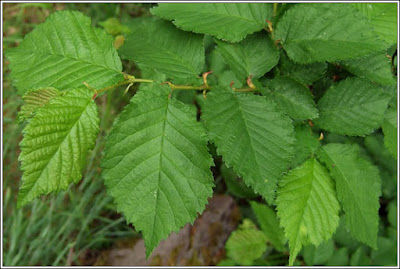|
|
 |
| Ulmus procera – English Elm |
The young shoots branch from the stem at an angle of about
600 whereas IN Wych Elm they are about 900. The long
shoots have a zigzag growth, and some are irregularly ridged with a corky
substance – they are then called ‘subeose’. The small winter buds are of a
darker brown than the twigs; they are oval, end in a blunt point, and show
several scales. The leaves are oval, with a much toothed margin and a short point;
at the base they are oblique or uneven (asymmetrical), and the upper surface is
roughened by short hairs. Patches of the foliage turn golden yellow in late
summer, but the autumn leaves are among the latest of deciduous trees to fall.
The clusters of bi-sexual precocious flowers are purplish-crimson,
and in mass give a reddish tinge to the whole crown when they appear during
February or early March clustered close on the leafless twigs. The fruit, a
seed (samara) is also formed before the leaves, and lies in the center of a
pale green oval wing which is transparent, and notched at the apex. The wings
cling festooned in masses of dense green cluster until June when they turn
brown and then fall. Fertile seeds are rarely produced in spite of the numerous
fruits that develop. English Elm is therefore usually established by rooted
suckers.
In outline the tree is usually tall, with two, three or four
tiers of crown, and very rarely forked. The grey bark, smooth at first, becomes
thick and furrowed into rather narrow ridges or dark grey-blackish squares. The
trunk often carries burrs and tufts of epicormics shoots. The heartwood is
reddish or dark brown, coarse-textured, strong, firm and heavy, usually with an
interlocked grain – hence it is extremely difficult to split and has a tendency
to warp. It is long lasting if kept either continuously dry or continuously
wet. Among its uses are coffin boards, chairs, tables, cabinets, stools,
underwater goods, and furniture for house and garden.
 |
| Ulmus procera – English Elm in Autumn |
 |
| Leaves of English Elm |
 |
| Leaves of Ulmus procera |
 |
| English Elm Leaves in Autumn |
 |
| Ulmus procera – English Elm Leaves |
 |
| Flowers of English Elm |
 |
| Flowers of Ulmus procera |
 |
| Ulmus procera – English Elm Flowers |
 |
| Seeds of English Elm |
 |
| Seeds of Ulmus procera |
 |
| Ulmus procera – English Elm Seeds |
 |
| Trunks of English Elm |
 |
| English Elm as Ornamental Plant |
 |
| English Elm as Ornamental Plant in Autumn |
 |
| English Elm in Autumn |
 |
| Ulmus procera in Autumn |
 |
| Ulmus procera – English Elm |
Elm:
2 comments:
It's very sad the way that the English Elm is disappearing from the English landscape. It looks like the ash is next :-(
CLICK HERE for Bazza’s fabulous Blog ‘To Discover Ice’
How you confirm this is not English Elm?
Post a Comment